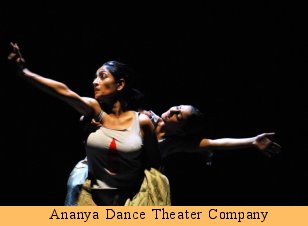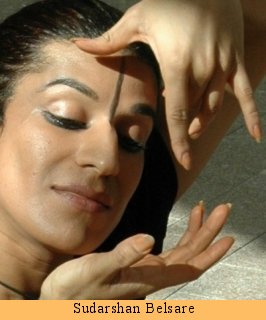
Erasing
Borders: Festival of Indian dance: A reflection
- Diditi Mitra
e-mail: diditimitra@aol.com
August 27,
2008
The recent
Indian dance festival sponsored by the Indo - American Arts Council in
New York City concluded with a set of performances that varied in their
content, dance styles and their choreographies. This review is based on
the performances on the final evening of the festival. A total of six companies
presented their works that evening. While the performances by Dakshina/Daniel
Phoenix Singh Dance Company's presentation of Bell Song and Sinha
Danse's presentation of Quebasian Rhapsody elevated my spirits with
their thoughtful and exciting exploration of movement, space and music,
the presentations of Sath Safed by Maria ColacoDance and Daak
by Ananya Dance Theater Company forced me to focus on the disadvantaged
workers of the developing world. In contrast, Carmine Bees presented
by Sudarshan Belsare and Ardhanarishwara by Nayikas Dance Theater
and Rudrakshya used mythologies from Buddhism and Hinduism respectively
in order to challenge patriarchal social expectations. Together, the diverse
dance forms and the diverse content of the choreographies compelled me
to ponder the meaning and the possibilities of "erasing borders."
 Expanding
one's sense of self and space that embraces stories of people who are seemingly
different is one pathway to "erasing borders." Maria Colaco's choreography
on the Kashmiri carpet weavers attempted to do so by stretching the national
and cultural borders to include stories of people that are clearly distinct
from hers as a South Asian American woman. Similarly, Ananya Chatterjea's
performance on the ongoing struggle for land rights by women of Nandigram,
West Bengal demonstrated a need to widen one's world to include places
and people who may seem disconnected from our everyday lives, but are certainly
part of the global space that all of us inhabit. A global social consciousness
and a desire to understand connections between multiple social realities
that were evidenced in the choreographies of Colaco and Chatterjea are
certainly commendable and much needed. Expanding
one's sense of self and space that embraces stories of people who are seemingly
different is one pathway to "erasing borders." Maria Colaco's choreography
on the Kashmiri carpet weavers attempted to do so by stretching the national
and cultural borders to include stories of people that are clearly distinct
from hers as a South Asian American woman. Similarly, Ananya Chatterjea's
performance on the ongoing struggle for land rights by women of Nandigram,
West Bengal demonstrated a need to widen one's world to include places
and people who may seem disconnected from our everyday lives, but are certainly
part of the global space that all of us inhabit. A global social consciousness
and a desire to understand connections between multiple social realities
that were evidenced in the choreographies of Colaco and Chatterjea are
certainly commendable and much needed.
 However,
Colaco and Chatterjea's choreographies would have been strengthened by
a more careful consideration of the contexts in which the Kashmiri carpet
weavers and the women of Nandigram are located. The costumes that reflected
the aesthetic of the local were an important way in which the stories could
have been contextualized. Whereas the dancers in Sath Safed wore
costumes that are typically associated with modern dancers, the dancers
in Daak wore costumes that reminded me of army fatigues. It was
difficult for me to relate the bodies on stage to the people whose stories
were being told. The static dance movements and the facial expressions,
especially in Daak, may have also been a reason why I was unable
to visualize and feel the people on whom the narrative was based. Additionally,
the choice of background score exoticised the local. Burial and/or marketing
of the local in order to imagine the global only silenced the voices from
below and reproduced the very hierarchies that Colaco and Chatterjea set
out to dismantle. However,
Colaco and Chatterjea's choreographies would have been strengthened by
a more careful consideration of the contexts in which the Kashmiri carpet
weavers and the women of Nandigram are located. The costumes that reflected
the aesthetic of the local were an important way in which the stories could
have been contextualized. Whereas the dancers in Sath Safed wore
costumes that are typically associated with modern dancers, the dancers
in Daak wore costumes that reminded me of army fatigues. It was
difficult for me to relate the bodies on stage to the people whose stories
were being told. The static dance movements and the facial expressions,
especially in Daak, may have also been a reason why I was unable
to visualize and feel the people on whom the narrative was based. Additionally,
the choice of background score exoticised the local. Burial and/or marketing
of the local in order to imagine the global only silenced the voices from
below and reproduced the very hierarchies that Colaco and Chatterjea set
out to dismantle.
Using the available
cultural tools to raise questions from within in order to question social
boundaries is another avenue to "erasing borders." This was precisely the
intention of the performances by Sudarshan Belsare and Nayikas Dance Theater
and Rudrakshya. Belsare's work used Buddhist mythology based on the story
of the goddess Kurukulla in order to question dominant notions of maleness
as a prerequisite for the achievement of enlightenment. The performances
by Nayikas and Rudrakshya, in contrast, used the dance idiom of Odissi
to depict the idea of the Ardhanarishwara in order to critically
reflect on the socially constructed borders of male and female that comprise
gendered social arrangements. While a noble objective, the choreographers
needed to place this "nonsexist" tool within the broader frame of sexism
that is very much a part of at least Hinduism. Also, the sacred thread
worn by the dancers in Rudrakshya that represent membership in the upper
castes within the Hindu tradition challenged the choreographers stated
goal of "erasing borders."
 Integration
of diverse cultural forms for the development of something new is another
way to break down barriers. I found Daniel Phoenix Singh and Roger Sinha's
mélange of at least modern and Bharatanatyam to be absolutely delightful.
Their dancing reflected their versatility and their skillfulness as dancers.
The ease with which they moved demonstrated their embodiment of both modern
dance and Bharatanatyam. Their keen musical sensibilities were also reflected
in their choice of music and its use as a tool to enhance their performances.
The effective use of space by both groups of dancers further enhanced their
choreographies. Through their choreographies, both Singh and Sinha, were
able to show the importance of respecting the local for an honest attempt
in "erasing borders." Integration
of diverse cultural forms for the development of something new is another
way to break down barriers. I found Daniel Phoenix Singh and Roger Sinha's
mélange of at least modern and Bharatanatyam to be absolutely delightful.
Their dancing reflected their versatility and their skillfulness as dancers.
The ease with which they moved demonstrated their embodiment of both modern
dance and Bharatanatyam. Their keen musical sensibilities were also reflected
in their choice of music and its use as a tool to enhance their performances.
The effective use of space by both groups of dancers further enhanced their
choreographies. Through their choreographies, both Singh and Sinha, were
able to show the importance of respecting the local for an honest attempt
in "erasing borders."
So, I come
back to the two questions I raised in the beginning of this review. Firstly,
is it possible to "erase borders?" The uneven global space that we occupy
makes it difficult to do so. At least in the works of Chatterjea and Colaco
what I presumed is a desire to erase signs of the local in order to make
the product palatable to the "global" (read: Western) audience. This form
of packaging of issues by both choreographers was likely to have fed the
Western liberal mind that feels the need to rescue the oppressed, especially
those in the Third World. In that case, instead of "erasing borders," the
existing ones are simply being reinforced. Secondly, what does it mean
to "erase borders?" As the performances of Singh and Sinha show, it is
necessary to attain deep knowledge and understanding of the local in order
to build bridges and create a kind of global that is able to respect and
grant legitimacy to all involved. To put it in a slightly different way,
understanding the self, howsoever defined, is a necessary prerequisite
for building relationships, and hence, it is also a necessary prerequisite
for the eventual erasure of borders.
Diditi
Mitra is a Sociologist, Kathak dancer, and a member of Courtyard Dancers,
a Philadelphia based dance theater group. |

